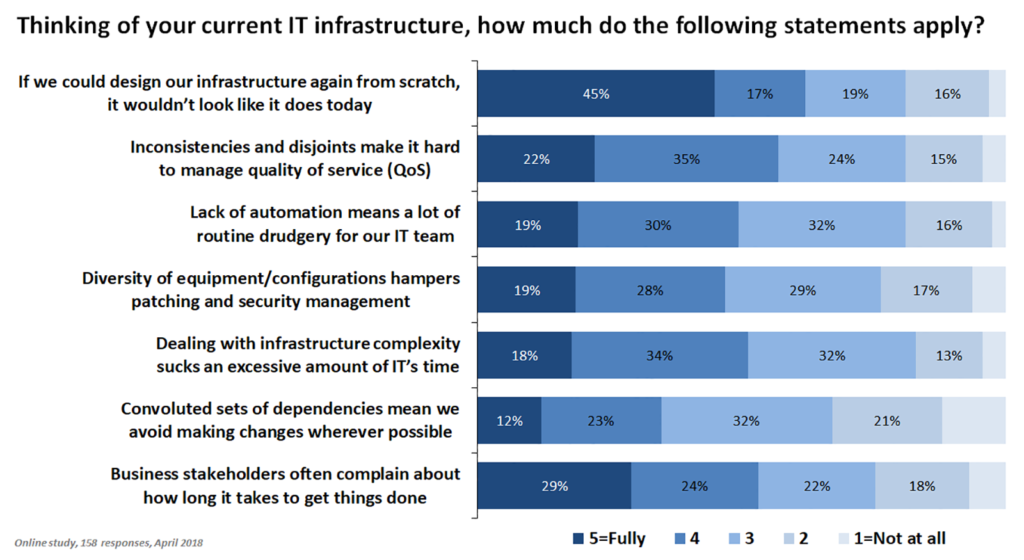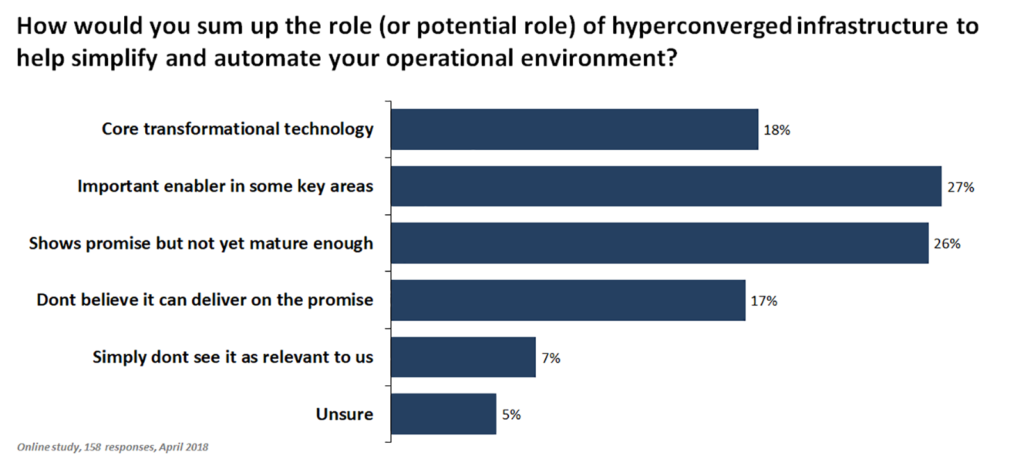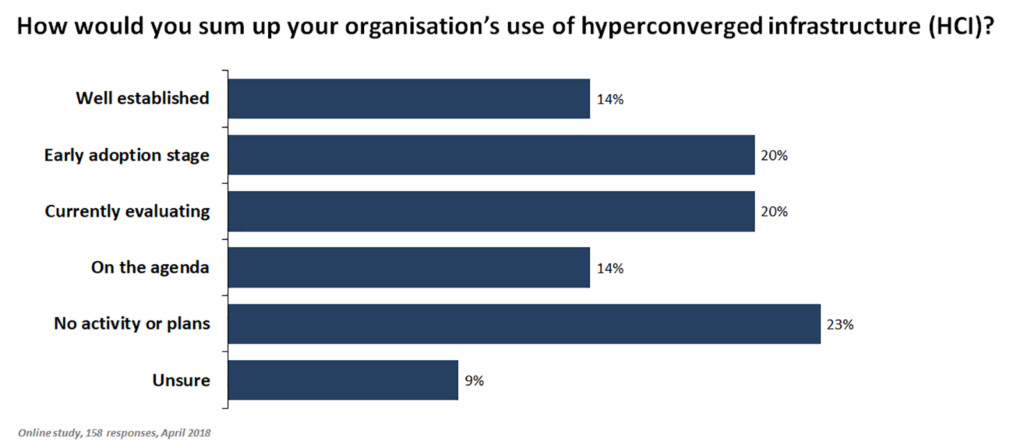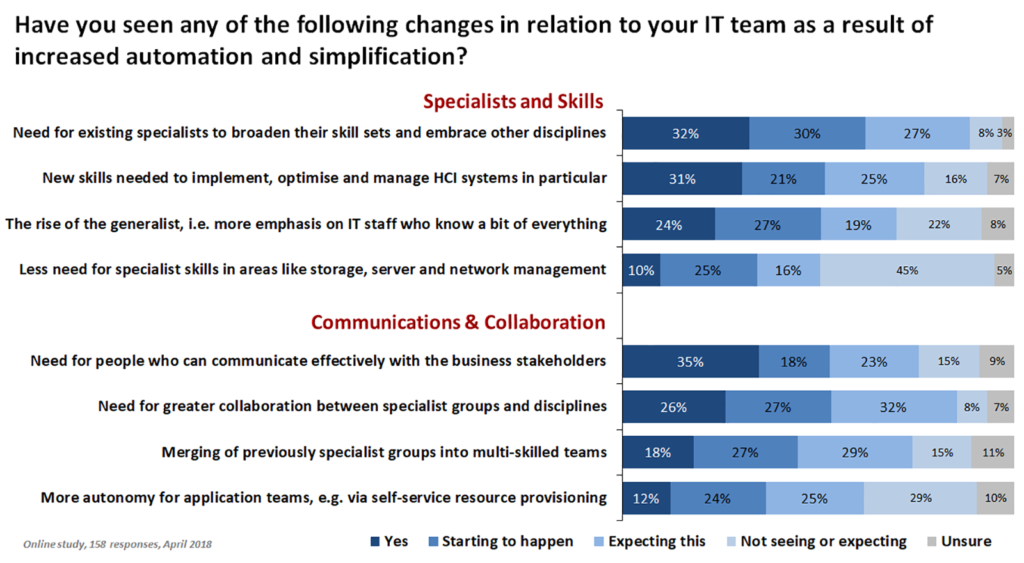
The way we build data centre systems is always in a state of flux. In theory, it is dictated by the operational needs of the business, the way IT seeks to architect its capabilities, and the developments brought to market by IT vendors. In practice though, data centre evolution for most organisations can be as much a matter of Darwinian evolution as it is guided by carefully planned long-term designs.
Recent research by Freeform Dynamics shows that one thing most data centre managers can probably agree on is, “If I wanted to get there, I wouldn’t start from here!” In other words, if we could build everything today as a greenfield site, rather than having to move forwards from where we are, our data centres would be very, very different (Figure 1).

As the chart shows, the data centre professionals we surveyed cited various reasons why they would like to design things differently. Many of them are, quite simply, direct consequences of the fact that most enterprise data centres are built in spurts to meet succeeding business requirements, as and when budgets for IT investment are made available. Indeed, web-scale operators are pretty much the only ones who can avoid constantly being in ‘reactive mode’.
This inevitably leads to computer rooms with a wide range of equipment, much of which was neither procured nor installed with the big picture in mind. This results in disjoints, inconsistencies and convoluted dependencies which make every new change a challenge, and quality of service difficult to regulate or vary. And as the last result in the chart shows, this can significantly and detrimentally affect how business stakeholders see IT’s effectiveness at meeting their needs speedily.
Two of the points in the research chart highlight challenges that HCI (hyperconverged infrastructure) was developed to address. Most notably, that’s the current shortage of automation, which means that IT professionals must deal with low value, routine drudgery, and the excessive drain on time that results from the challenges of IT infrastructure complexity. But do data centre professionals think HCI can help? (Figure 2).

While many believe that HCI could help to simplify and automate their IT infrastructures, at least in some areas, significant numbers think that while it has potential, it is not yet mature enough for them to deploy. And around one in five think it cannot deliver on the promises made in it its name, or simply don’t think it is relevant for them. This is hardly surprising as despite the many promises made by the marketing departments of IT vendors over the years, no one has yet invented a magic solution that can answer every IT complexity challenge.
Despite these concerns, HCI has already made an impact, with around one in seven respondents saying that its usage inside their organisations is already well established (Figure 3).

Beyond these early adopters, 40 percent of respondents are in the early stages of deployment or evaluating HCI, and another 14 percent have it on their agenda. The fact that almost a quarter have no activity or plans for HCI with another one in ten simply unsure about usage indicates that the industry may still have an education task ahead.
There is no doubt about the desire to simplify data centre operations and make greater use of automation, both to improve service and minimise risk, and to allow IT professionals to focus less on Infrastructure management and more on delivering additional business value. So if HCI isn’t the big answer to the question of IT, the universe and everything, how can we move forward? The answers are ones that it can be easy to overlook in our high-tech world: People, process and skills (Figure 4).

The results show that building and running the modern data centre requires IT professionals to extend their skills. Clearly, new skills will be needed to administer the new technologies as they come along, and HCI is no exception. But the combination of processing, storage and networking embedded in HCI systems is also reflected in the fact that the vast majority of respondents also see a need for IT specialists to broaden their skills to cover other disciplines. This requirement or expectation is not new, and has turned up regularly over the years in the surveys that Freeform Dynamics undertakes.
But the need for IT people to add to their skills also spreads into softer, people related areas. In particular, the survey shows how important it is now for IT teams to collaborate effectively across disciplines, but even more essential is the need for IT people to be able to communicate effectively with business stakeholders. Only by enabling regular interaction with business users can data centre professionals ensure not only that IT delivers what users need, but also that they can show stakeholders how IT can help them change as well.
The effective marketing of new IT solutions to business users gives IT professionals a chance to get onto the front foot in the relationship between IT and the business. Now IT has the potential to enable the business not just to work cost-effectively, but to work differently and expand into new areas. Remodelling how we build and run data centres gives IT professionals an opportunity to really show not only the business importance that IT delivers today, but also the potential value it can add tomorrow and in the years to come.
Originally published on DCS UK